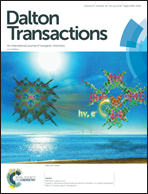Manganese-52: applications in cell radiolabelling and liposomal nanomedicine PET imaging using oxine (8-hydroxyquinoline) as an ionophore†
Abstract
The ionophore 8-hydroxyquinoline (oxine) has been used to radiolabel cells and liposomal medicines with 111In and, more recently, 89Zr, for medical nuclear imaging applications. Oxine has also shown promising ionophore activity for the positron-emitting radionuclide 52Mn that should allow imaging of labelled cells and nanomedicines for long periods of time (>14 days). However, to date, the radiometal complex formed and its full labelling capabilities have not been fully characterised. Here, we provide supporting evidence of the formation of [52Mn]Mn(oxinate)2 as the metastable complex responsible for its ionophore activity. The cell labelling properties of [52Mn]Mn(oxinate)2 were investigated with various cell lines. The liposomal nanomedicine, DOXIL® (Caelyx) was also labelled with [52Mn]Mn(oxinate)2 and imaged in vivo using PET imaging. [52Mn]Mn(oxinate)2 was able to label various cell lines with moderate efficiency (15–53%), however low cellular retention of 52Mn (21–25% after 24 h) was observed which was shown not to be due to cell death. PET imaging of [52Mn]Mn-DOXIL at 1 h and 24 h post-injection showed the expected pharmacokinetics and biodistribution of this stealth liposome, but at 72 h post-injection showed a profile matching that of free 52Mn, consistent with drug release. We conclude that oxine is an effective ionophore for 52Mn, but high cellular efflux of the isotope limits its use for prolonged cell tracking. [52Mn]Mn(oxinate)2 is effective for labelling and tracking DOXIL in vivo. The release of free radionuclide after liposome extravasation could provide a non-invasive method to monitor drug release in vivo.

- This article is part of the themed collection: Frontiers in Radionuclide Imaging and Therapy


 Please wait while we load your content...
Please wait while we load your content...